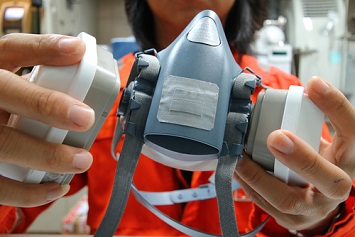The National Institute for Occupational Safety and Health (NIOSH) recently approved the first elastomeric respirator without an exhalation valve, developed by the Mine Safety Appliance (MSA) Corporation. Elastomeric respirators are half-facepiece or full-facepiece respirators made with a facepiece of synthetic or natural rubber material that can be repeatedly used, cleaned, disinfected, stored, and reused.
Elastomeric models typically have exhalation valves for user comfort. U.S. healthcare facilities began using elastomeric half mask respirators (EHMRs) in response to shortages of single-use, disposable filtering facepiece respirators (FFRs) during the COVID-19 pandemic. The presence of an exhalation valve raised concerns about the effectiveness of EHMRs for infection source control. The MSA model directs expelled air back through the respirator’s filters instead of through an exhalation valve.
NIOSH also approved an accessory filter for a series of EHMRs made by the 3M Corporation. The accessory filter reduces exhaled particles from inside the elastomeric respirator, using new technology that cleans the exhaled breath that passes through the exhalation valve.
NIOSH also revealed a number of research projects at the institute into respiratory protection technology, including:
- Factors affecting the efficiency of exhalation valves as source control, such as respiratory droplet size and composition, the movement of particles through the exhalation valve, and changes in the air breathed through a respiratory device;
- Developing a reusable elastomeric respirator for use in health care with features desired by healthcare workers, such as filtering the exhaled breath; and
- Designing exhaled breath filter adaptors for select commercial respirators.
Face Mask, Neck Gaiter, Face Shield Research
NIOSH also recently completed research into face masks, neck gaiters, and face shields to see how well they block the small aerosol particles produced by people when they cough. Results of the study appeared in the report “Efficacy of face masks, neck gaiters and face shields for reducing the expulsion of simulated cough-generated aerosols,” published in Aerosol Science and Technology.
Researchers examined mask, gaiters, and face shields for their effectiveness for infection source control, not as personal protective equipment, to prevent aerosols in the environment from being inhaled by the wearer, according to NIOSH biomedical research engineer William Lindsley. Researchers found that a three-ply cotton face mask blocked 51% of the cough aerosol particles, and a polyester neck gaiter blocked 47% as a single layer and 60% when folded into a double layer. Face shields only blocked 2% of particles.
While the Centers for Disease Control and Prevention (CDC) and other public health organizations have recommended the use of face masks to reduce community transmission of SARS-CoV-2, the virus that causes COVID-19, information about face shields and neck gaiters as source control devices has been limited.
NIOSH intends to conduct further research, looking at how different mask and gaiter materials perform, the effect of face covering fit, and the effectiveness during breathing versus coughing. The institute also would like to test alternative designs for face shields, as well as test all devices using a broader size range of aerosol particles.

